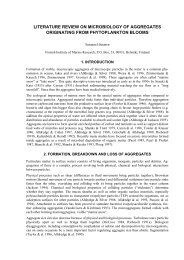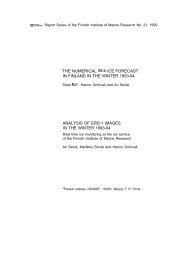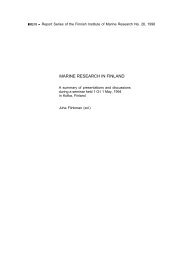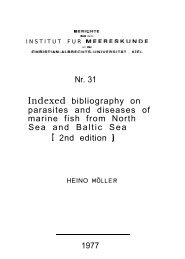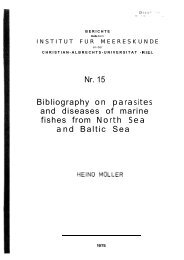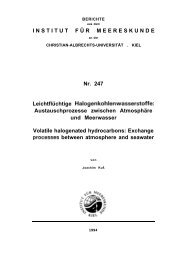BALTIC SEA ENVIRONMENT PROCEEDINGS No. 80
BALTIC SEA ENVIRONMENT PROCEEDINGS No. 80
BALTIC SEA ENVIRONMENT PROCEEDINGS No. 80
- No tags were found...
You also want an ePaper? Increase the reach of your titles
YUMPU automatically turns print PDFs into web optimized ePapers that Google loves.
from the outside, redistribution, resuspension and loss of enclosed matter (Blomqvist, 1992). Large boxcorers are often cumbersome and require the use of large research vessels. In addition, their massiveconstruction, weight and less hydrodynamic design tend to disturb the soft surface layers of thesediment, even if flaps allow for water flow through the open box, as in these devices. A supportingstand or frame is used to reduce tilting and brimming. However, the Large Box Corer, specificallyproved to be too heavy for the soft bottoms of the Baltic Sea, and the soft surface layers were often lostdue to scavenging or brimming.A box corer is not the best sampling device available for very soft seabeds, although it has manyadvantages in sampling of hard clayey and sandy sediments. It is thus obvious that the same corer maynot be appropriate in all cases, and that different bottoms and circumstances require different devices. Onvery soft bottoms the main disadvantage of the box corer is its rather massive design, which causes lossof very soft surface sediments and makes of the corer sink too deeply into the sediment, resulting inbrimming of the coring barrel.The smaller Aquarius Box Corer is also equipped with a frame to avoid tilting and filling up to thebrim. In addition, it is lighter and handier than the large box corers and allows water flow through theopen box during descent and penetration into the sediment. Sample handling relies on an inner Plexiglasbox (aquarium) that can be removed from the corer, after which the entire core can be thinly sliced usinga sectioning device modified from that in the Niemistö Corer. Scavenging may be the main risk in use ofthe Aquarius Box Corer. However, very good samples were obtained in careful sampling with this corerduring the MOSSIE exercise. Before the corer was equipped with the frame, tilting often caused theappearance of a wedge-shaped gap in one edge of the core, but the frame reduced this disadvantage.CONCLUSIONSTo be able to study sedimentation and processes in sediments, it is essential to obtain reliable samples.False conclusions are an obvious risk if the studies are based on biased field samples, and it isunreasonable to perform exacting and expensive analyses if the samples themselves are unreliable or ofpoor quality. Sampling of soft, easily resuspended sediments, however, is difficult and involves manysources of error. In many cases the surface of the sediment is like a "line drawn in water", because theuppermost sediment layers usually consist of very light, mobile particles. Thus, sampling of sediments isone of the most demanding tasks in marine research. Different sources of error are associated withdifferent sampling equipment, and probably there is no single corer which is ideal for all kinds ofsediments.Despite the large variety of sampling instruments and the many sources of error involved in the use ofdifferent instruments, it is vital to know and account for the disadvantages and to work as reliably andcarefully as possible to minimise errors and obtain undisturbed and reliable samples.The instruments best suited to quantitative sampling of soft-bottom sediments appear to be those basedon the coring principle. Box corers can be reliably used mainly for bulk sampling of coherent sedimentsand some silty and sandy sediments. Nevertheless, it should be borne in mind that the same instrumentmay not be the best alternative for all types of bottom, and different circumstances require different typesof instrumentation.




